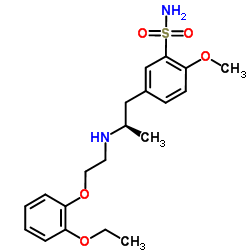106463-17-6
| Name | tamsulosin hydrochloride |
|---|---|
| Synonyms |
TAMSULOSINHCL
TAMSOLUSIN HYDROCHLORIDE YM 12617-1 (R)-Tamsulosin (R)-5-(2-((2-(2-Ethoxyphenoxy)ethyl)amino)propyl)-2-methoxybenzenesulfonamide hydrochloride 5-[(2R)-2-{[2-(2-Ethoxyphenoxy)ethyl]amino}propyl]-2-methoxybenzolsulfonamidhydrochlorid Tamsulosin HCl Tamsulosin hydrochloride Yutanal YM-617 UNII:11SV1951MR 5-[(R)-2-[2-(2-Ethoxyphenoxy)ethylamino]propyl]]-2-methoxybenzenesulfonamide Hydrochloride (R)-TAMSULOSIN HCL 5-[(2R)-2-[[2-(2-Ethoxyphenoxy)ethyl]amino]propyl]-2-methoxybenzenesulfonamide hydrochloride Yutana TAMSULOSINE HYDROCHLORIDE FLOMAX benzenesulfonamide, 5-[(2R)-2-[[2-(2-ethoxyphenoxy)ethyl]amino]propyl]-2-methoxy-, monohydrochloride Benzenesulfonamide, 5-[(2R)-2-[[2-(2-ethoxyphenoxy)ethyl]amino]propyl]-2-methoxy-, hydrochloride (1:1) TAMSULOSIN HYDROCHLORIDE , CERTIFIED REFERENCE MATERIAL Tamsulosin (hydrochloride) MFCD00922997 PRADIF (R)-TAMSULOSIN HYDROCHLORIDE,WHITE TO OFF-WHITE SOLID (R)-Tamsulosin Hydrochloride (R)-5-[2-[[2-(2-Ethoxyphenoxy)ethyl]amino]propyl]-2-methoxybenzenesulfonamide monohydrochloride TAMSOLUSIN HCL 5-[(2R)-2-{[2-(2-Ethoxyphenoxy)ethyl]amino}propyl]-2-methoxybenzenesulfonamide hydrochloride (1:1) (-)-(R)-5-[2-[[2-(o-Ethoxyphenoxy)ethyl]amino]propyl]-2-methoxybenzenesulfonamide monohydrochloride HARNAL OMNIC (R)-5-(2-((2-(2-Ethoxyphenoxy)ethyl)amino)propyl)-2-methoxybenzenesulfonamide hydrochloride ee 5-[(2R)-2-{[2-(2-éthoxyphénoxy)éthyl]amino}propyl]-2-méthoxybenzènesulfonamide chlorhydrate Omic |
| Description | Tamsulosin hydrochloride((R)-(-)-YM12617;LY253351) is a selective α1 receptor antagonist.Target: α1 receptorTamsulosin is a selective α1 receptor antagonist that has preferential selectivity for the α1A receptor in the prostate versus the α1B receptor in the blood vessels. Tamsulosin-treated patients had a 0.30-fold lower risk of developing acute urinary retention compared with control patients. None of the International Continence Society male questionnaire domain scores showed significant changes between the groups [1]. tamsulosin can be recommended for treating men after catheterization for AUR, and can reduce the likelihood of the need for re-catheterization [2]. |
|---|---|
| Related Catalog | |
| References |
| Boiling Point | 595.5ºC at 760 mmHg |
|---|---|
| Melting Point | 228-230ºC |
| Molecular Formula | C20H29ClN2O5S |
| Molecular Weight | 444.973 |
| Flash Point | 313.9ºC |
| Exact Mass | 444.148560 |
| PSA | 108.26000 |
| LogP | 4.51290 |
| Vapour Pressure | 3.79E-14mmHg at 25°C |
| Storage condition | Desiccate at RT |
CHEMICAL IDENTIFICATION
HEALTH HAZARD DATAACUTE TOXICITY DATA
|
| Symbol |

GHS07 |
|---|---|
| Signal Word | Warning |
| Hazard Statements | H302-H315-H319-H335 |
| Precautionary Statements | P301 + P312 + P330-P305 + P351 + P338 |
| Hazard Codes | Xn |
| Risk Phrases | 22-36/37/38 |
| Safety Phrases | 26 |
| RIDADR | NONH for all modes of transport |
|
~% 
106463-17-6 |
| Literature: EP2172443 A1, ; Page/Page column 12 ; |
| Precursor 1 | |
|---|---|
| DownStream 0 | |

